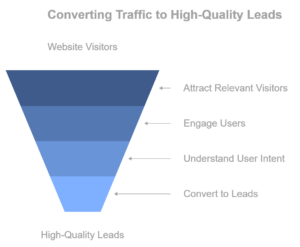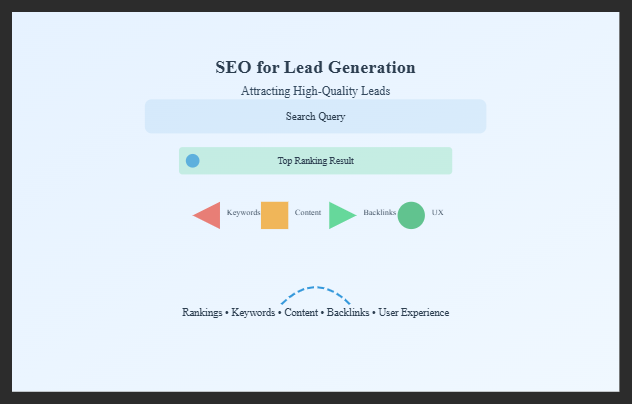With all that competition in the digital world of today, attracting visitors to the websites of businesses is not quite enough unless it matches up with the interest of visitors in what they offer. SEO, or Search Engine Optimization, comes into the picture here. In simple words, SEO is a strategic process applied in order to make a website more visible for the search on particular information, products, or services offered.
However, effective SEO is not merely driving traffic. It’s more about getting high-quality lead people who are not visiting just out of curiosity but are likely to engage, subscribe, or make a purchase. Unlike normal traffic, quality leads bring in great value as they have an actual interest in what a business has to offer. This happens only if businesses adapt their SEO strategies to include relevant keywords, understand user intent, and publish meaningful content.
Those efforts help businesses attract such people and convert them so they get maximum return on their investments. Thus, through making sure that the right people come in, rather than merely more people, SEO is an incredibly effective business growth driver.
This post explains why SEO matters in terms of generating lead quality and lays down actionable strategies to make sure that visitors are caught properly as valuable clients.
Understanding High-Quality Leads

Quality leads are those individuals who have an interest in products or services being offered by an organization and therefore are likely to buy or sign up, etc. Comparatively, quality leads are near a business’s target audience whereas casual visitors are not. And that is why quality leads have been considered the most treasured asset for commercial growth.
The difference between general traffic and high-quality leads lies in engagement and the ability to convert. General traffic only increases the total number of visitors visiting a website but does not guarantee engagement or contemplation of a purchase. High-quality leads are more likely to be actively engaged- they browse the site, explore the content, and reach out for more information or order.
Quality lead attention helps companies realize the maximum conversion ratio possible and increases sales. They reduce marketing costs since more visitors are likely to convert.
Key SEO Strategies for High-Quality Lead Generation

a. Keyword Research & Targeting
The key to bringing in leads who actually care about a business’s offerings is finding the right keywords. By choosing keywords with buyer intent—words and phrases that customers are likely to use when they’re ready to buy—a business will connect with high-quality leads at the right time. Long-tail keywords often attract more qualified leads, as they tend to represent focused searches. For instance, “affordable eco-friendly skincare products in [city]” is closer to finalizing a decision than “skincare.”
b. On-Page SEO
On-page SEO makes sure the right people view and click on the business’s website. Optimized meta descriptions, title tags, and headings can increase the visibility of a website within the search results but also attract an audience interested in what the business offers. When these elements are well designed, they set up expectations, making relevant users want to go to the site. Properly structured content, helping visitors quickly find what they are looking for, ensures engagement, and keeps the most relevant visitors interested.
c. Content Creation & Optimization
One of the most powerful means of attracting high-quality leads is content. Creating valuable, informative, and engaging content—blog posts, guides, product pages, and so on—is just one of the ways that businesses can talk to audiences by answering their questions, needs, or pain points. Optimized, keyword-rich content does two things: it ranks well on search, and it also speaks directly to the concern of potential leads. So, given that visitors with concerns are likely to value that content, it is more likely they will convert to leads.
d. Technical SEO
Technical SEO is the technical side that determines the functionality of how well a website is. Generally, technical SEO will have a huge influence on the quality of leads. These essential features include a website’s speed, being mobile-friendly, and being secure, as marked by HTTPS. A website with high speeds will, by default, give better user experiences. A website is crucial because most users surf via their mobile phones. Having an HTTPS marks the establishment of trust by visitors. Only once these technical aspects have been put in place would it be easier for people to stay on the website longer and spend more time browsing its content, making their conversion to quality leads highly probable.
e. Local SEO (If Applicable)
Its applications are also the strongest, depending on the nature of its target customers for locally based businesses. For businesses in need of a constant consumer who resides within their proximity area, local SEO will perform miracles. This form of optimization focuses on local targeted keywords, Google My Business presence, and content-targeting locations. It attracts targeted searches that may use search strings such as “near me” or “best [service/product] in [city].”.
Role of User Experience (UX) in Lead Generation

UX and SEO go together to make a seamless and engaging journey with any website. SEO brings the visitor onto your site, but UX determines how they relate with it afterward, affecting staying, exploring, and ultimately leading to converting into leads. If the right audience is being targeted by SEO, then great UX can really seal the deal to transform visitors into loyal customers.
There are several key UX elements directly influencing lead generation:
Easy Navigation: a well-structured navigation that lets users quickly find what they are looking for, which means less bounce rate. More attention was paid to getting a user to go through various parts of the website: the higher the chances for longer stays and eventually conversion.
Mobile Responsiveness: Since most of their time on internet browsing has been on mobile devices, it would be a very unwise decision not to go for a mobile responsive design. Responsive design typically adjusts to the size of any device screen, thereby ensuring an optimal experience on whatever device the user is working with. It is essential for retaining customers who browse through on mobile. Most of these visitors are usually close to making purchasing decisions.
Relevant CTAs or Calls-to-Action: Strong, compelling CTAs tell the visitor where you want him or her to go-to sign up for a newsletter, download a resource, or buy a product, for instance. Relevant, top-of-screen, and easy-to-use CTAs are quite effective in enhancing the user experience since the next step is obvious and nudges visitors along in pursuit of conversion.
Effective SEO can be integrated with user-friendly design to develop a positive, engaging experience for businesses which, in turn, can attract more quality leads and solicit meaningful action from them.
Tracking and Measuring Lead Quality through SEO

Most importantly, the tracking and measurement of performances with reliable tools such as Google Analytics Google Search Console, or any CRM software will give you a better insight into the effectiveness of SEO in attracting the right audience.
The leading Keys for measuring quality leads are:
Conversion rate: This is simply the percentage of visitors who actually do what you want them to. It could be filling out your form, signing up for your newsletter, or making a purchase. The higher the conversion rate, the more qualified leads the site has that are interested in offerings.
Bounce Rate: A percentage of visitors, who, after viewing just one page, have left the site. A high bounce rate can indicate that the content is not as relevant or engaging for the targeted audience and may require changes to bring the value of higher quality leads.
Time on Page: This is the time spent on each page. The more time on the page, the more interested users are and likely to be quality leads interested in what the business has to offer.
Pages per Session: The number of pages viewed by a visitor within one session can also be regarded as an index of lead quality. More pages mean visitors could be interested, and more likely to convert.
Monitoring these metrics regularly will help understand the kind of quality of leads that the SEO effort has managed to produce for a business. In such a way, by closing this gap in strategy adjustment with the help of such data, SEO will attract the right audience who will eventually increase conversion and, thus, long-term growth.
Conclusion

This means high-quality leads via SEO can only be generated with a well-planned strategy that goes above and beyond just attracting traffic. A business will bring in not just visitors but interested visitors using targeted keywords, valuable content, technical optimization, and user-friendliness. It can measure the quality of leads through what conversion rate, bounce rate, and time on the page, allowing improvement strategies for even better results.
Growth will occur only through solid SEO strategies that integrate these aspects. While creating more visible and engaging content for visitors, SEO also offers better conversion rates to convert its visitors into a loyal customer.
